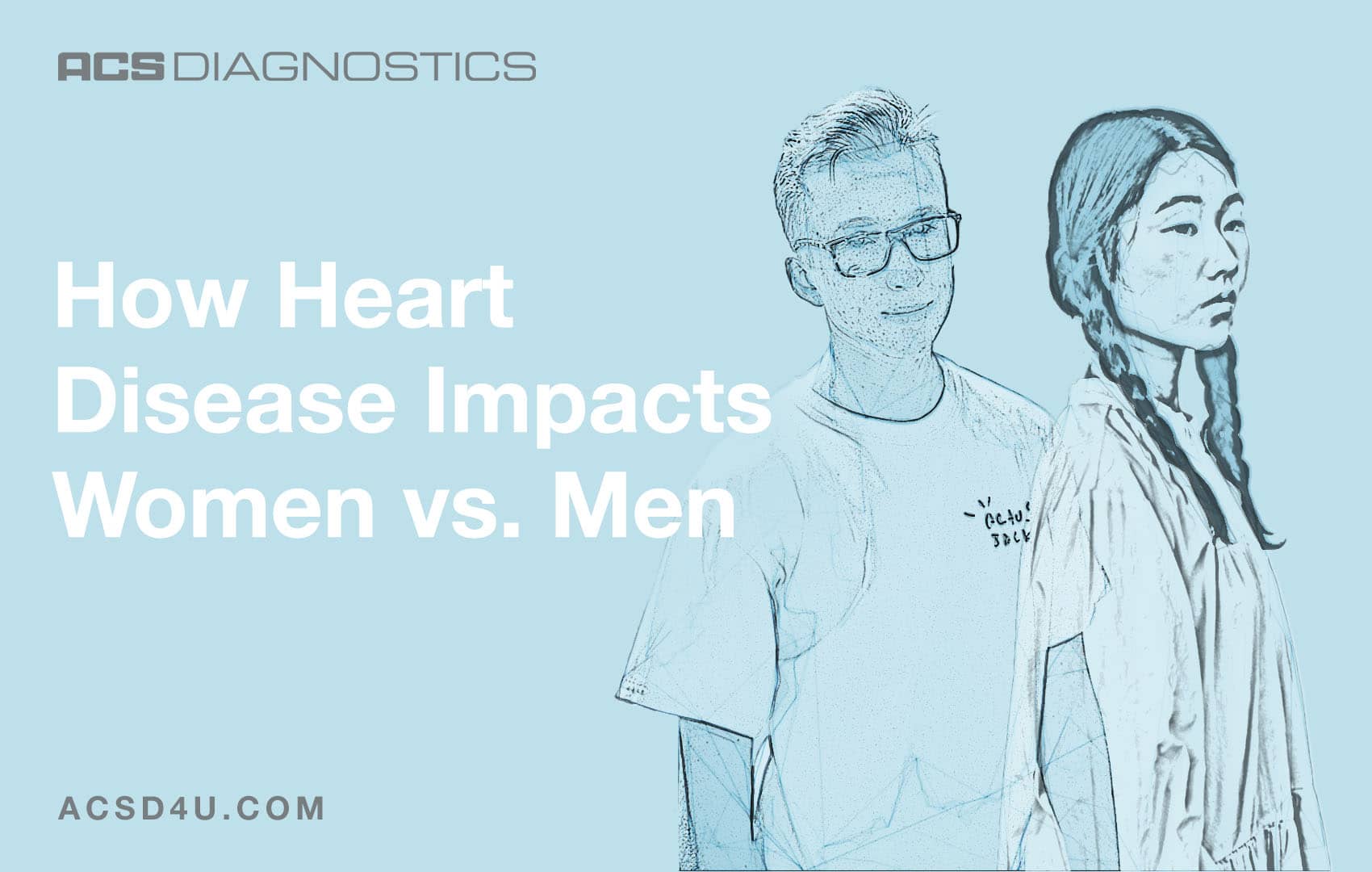
How Heart Disease Impacts Women vs. Men
Heart disease is the leading cause of death in the United States. More than 600,000 Americans die of heart disease each year. That’s one in every four deaths in this country. About half of all Americans (47%) have at least 1 of 3 key risk factors for heart disease: high blood pressure, high cholesterol, and smoking.
The term “heart disease” describes a range of conditions that affect your heart. The most common type is coronary artery disease, which can lead to heart attack. Other kinds of heart disease may involve valves in the heart, or the heart may not pump well and result in heart failure. Moreover, people can have congenital heart defects which means they were born with heart disease. Many forms of heart disease can be prevented with healthy lifestyle choices.
Heart disease can occur at any age, but the risk goes up as you age. In other words, men, women, and even children can develop heart disease. This happens when plaque builds up in your arteries and causes them to narrow over time, thus reducing blood flow to the heart. Smoking, eating an unhealthy diet, and not getting enough exercise all increase your risk for having heart disease. Additionally, having high cholesterol, high blood pressure, or diabetes can also increase your risk for heart disease.
Gender Differences
Gender differences exist in various heart disease conditions such as coronary heart disease, stroke, heart failure, and aortic diseases. As a result, these gender differences have caused widespread concerns and the consideration of gender differences is of great importance for the prevention, diagnosis, treatment and management of cardiovascular disease. This article aims to provide an overview of gender-related differences in several typical CVDs and to list and to analyze the possible causes associated with the differences, in order to highlight the necessity of taking into account gender differences in determination of the cardiovascular risk profile. Future research can focus on how to define and add gender-related indicators to current risk assessment and management strategies.
Cardiovascular disease develops 7 to 10 years later in women than in men. The risk of cardiovascular disease is often underestimated due to the misperception that females are “protected” against cardiovascular disease. Although the incidence of cardiovascular disease in women is usually lower than in men, women have a higher mortality rate and worse prognosis after acute cardiovascular events. The under-recognition of heart disease and differences in clinical presentation in women lead to less aggressive treatment strategies and a lower representation of women in clinical trials. Likewise, self-awareness in women and identification of their cardiovascular risk factors needs more attention. This should result in a better prevention of cardiovascular events.
Diagnosing Women with Heart Disease

A significant challenge for diagnosing women with heart disease is the lack of recognition of symptoms that might be related to heart disease. It is proven that women can develop symptoms that are subtler and harder to detect as a heart attack, especially if the physician is only looking for the “usual” heart attack symptoms. Dr. Lili Barouch, director of the Johns Hopkins Columbia Heart Failure Clinic, expresses that women are much more likely to have atypical heart attack symptoms. For instance, the classical symptoms such as chest pains apply to both men and women, but women are much more likely to get less common symptoms such as indigestion, shortness of breath, and back pain, sometimes even in the absence of obvious chest discomfort.
The Role of Estrogen
It is assumed that exposure to endogenous estrogens during the fertile period of life delays the manifestation of atherosclerotic disease in women. Before menopause the coronary heart disease event rate in women is low and predominantly attributed to smoking. According to the Framingham Heart Study, data suggests that a harmful cardiovascular risk profile may be more cause than consequence of age at menopause. Additionally, in the Women’s Ischemia Syndrome Evaluation study it was shown that young women with endogenous estrogen deficiency have a more than sevenfold increase in the coronary artery risk. Estrogens have a regulating effect on several metabolic factors, such as lipids, inflammatory markers and the coagulant system. After menopause atherosclerotic plaque composition changes into more vulnerable lesions with inflammatory factors involved.
Menopause transition is associated with a worsening CHD risk profile. Women with clinically manifest CHD are in general older than men, with a higher expression of cardiovascular risk factors. Although women and men share most classic risk factors, the significance and the relative weighting of these factors are different. For instance, at younger ages (<50 years) smoking is more deleterious in women than in men, with a larger negative impact on the total number of cigarettes smoked per day. Furthermore, it is proven that smoking increases the risk of a first acute myocardial infarction (AMI) relatively more in females than in men.
Traditional Risk Factors
Men and women share many heart disease risk factors, but recent studies are showing what previous male-focused studies have not shown: women also have their own unique heart disease risk factors.
Traditional risk factors common to both women and men:
- Obesity
- Smoking
- Diabetes
- High blood pressure
- Family history
- Metabolic syndrome – the coexistence of high blood pressure, obesity, and high glucose and triglyceride levels
- High levels of C reactive protein – a sign of inflammatory disease that can occur along with other cardiovascular risk factors
Risk Factors that Relate Specifically to Women

Some risk factors that relate specifically to women or that can affect women disproportionately include:
- Relatively high testosterone levels prior to menopause
- Increasing hypertension during menopause
- Autoimmune diseases such as rheumatoid arthritis – more common in women than in men
- Stress and depression – also more common among women
- Low risk factor awareness
Men and women display differences in their anatomy and physiology, from the lungs and brain to muscles and joints. Men and women also have differences in their cardiovascular systems. Compared to men, women have smaller hearts and narrower blood vessels. “Because of these biological differences, heart disease can progress differently in women when compared to men,” says Michelle O’Donoghue, MD, a cardiovascular medicine specialist at Brigham Health and senior investigator with the TIMI Study Group, where she leads clinical trials examining how heart disease differs between men and women.
And yet, until recently, women with heart disease have been diagnosed and treated like men – with the same tests, same procedures, and same medications.
Women are more likely than men to suffer from diseases that mimic a heart attack. For instance, women are more likely to experience the following:
- A coronary spasm: a blood vessel clamps down and mimics a heart attack.
- A coronary dissection: the wall of a blood vessel tears.
- Takotsubo cardiomyopathy: an inflammatory response that causes the heart to enlarge after an emotional stressor (also called broken heart syndrome).
Heart Disease isn’t Identical Across the Sexes
Heart disease and heart attack symptoms in women sometimes don’t include the “classic” angina or chest pain. Thus proving the importance of self awareness of risk factors. It is crucial to pay attention to your body and ask questions.
Heart disease is avoidable, even if it runs in your family. Lifestyle changes can have a large impact in preventing cardiovascular disease, or in keeping it from worsening.
It’s important to recognize the signs and symptoms of a heart attack, which can include uncomfortable pressure, burning, or squeezing sensations in the chest, and pain in the chest, neck, arm, or back.
Be mindful that heart attack symptoms are not the same for everyone. Women are more likely to experience nausea, sweating, vomiting, and pain in the neck, jaw, throat, abdomen or back.
Everyone, regardless of age and medical history, should routinely visit their primary care doctor. It is important to stay up to date on recommended CVD screenings, specifically cholesterol, diabetes, and blood pressure checks. During these visits, you should ask your doctor about your individual risk for CVD. Finally, everyone — but women especially — should be aware of the signs and symptoms of CVD.
ACS Diagnostics, Inc.
Know what is going on in your heart. If you have any arrhythmias or heart issues, contact us today. ACS Diagnostics can get you in touch with a Cardiologist, or get a remote test sent directly to your home. Don’t ignore your heart, take control today!
